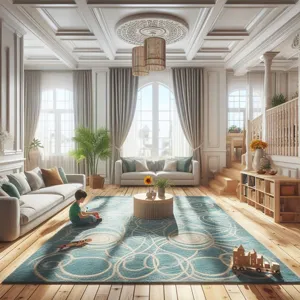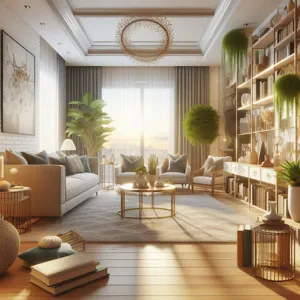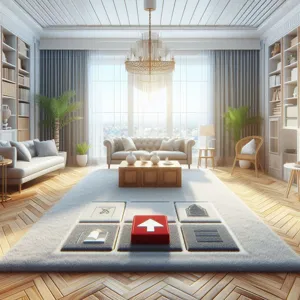Choosing the right carpet for your home is more than just a decision about aesthetics; it’s an investment in comfort, style, and functionality that can transform your living space.
With a plethora of colors, textures, and materials available, navigating the world of carpets can feel overwhelming. The perfect carpet should not only complement your interior design but also withstand the daily wear and tear of your lifestyle, whether you have kids, pets, or frequent guests. In this ultimate guide, we will explore the key factors to consider when selecting the ideal carpet for your home, from fiber types and pile styles to color schemes and maintenance tips. Whether you’re seeking a plush retreat for your bedroom, a durable option for high-traffic areas, or a chic statement piece for your living room, this comprehensive guide will equip you with the knowledge you need to make an informed choice that enhances your home’s comfort and beauty.
1. Understanding Different Types of Carpets

When it comes to selecting the perfect carpet for your home, understanding the various types available is paramount. Carpets come in a multitude of materials, styles, and constructions, each with its own unique advantages and aesthetic appeal.
**1. Fiber Types:** The first step in your carpet journey is to familiarize yourself with the different fibers. Wool carpets are renowned for their luxurious feel and durability, offering natural insulation and resistance to stains. Synthetic fibers, such as nylon and polyester, provide a more budget-friendly option while still delivering impressive durability and stain resistance. For those seeking eco-friendly solutions, consider carpets made from natural fibers like sisal or jute, which not only contribute to a sustainable environment but also add a unique texture to your space.
**2. Carpet Styles:** Next, consider the style of carpet that aligns with your home’s decor. Plush carpets feature a soft, velvety surface, ideal for creating a cozy atmosphere in bedrooms or living areas. Berber carpets, characterized by their looped construction, are exceptionally durable and perfect for high-traffic areas like hallways and family rooms. Frieze carpets, with their twisted fibers, offer a casual, textured look that can hide footprints and dirt, making them a practical choice for busy households.
**3. Construction Methods:** Lastly, familiarize yourself with the construction methods that impact both comfort and longevity. Cut pile carpets, where the loops are cut to create a soft surface, are popular for their plush feel. Loop pile carpets, on the other hand, maintain their shape and are less prone to wear, making them a great option for high-use spaces. Understanding these distinctions will not only help you choose a carpet that looks great but also one that withstands the test of time.
By gaining insight into these different types of carpets, you’ll be well on your way to making an informed decision that enhances the beauty and comfort of your home while catering to your lifestyle needs. Whether you prioritize luxury, durability, or sustainability, knowing your options is the key to finding the perfect carpet.
2. Key Factors to Consider When Choosing Carpet
Choosing the perfect carpet for your home is a decision that extends beyond mere aesthetics; it encompasses a range of practical considerations that can significantly impact your comfort, maintenance, and overall satisfaction. Here are the key factors to keep in mind as you embark on this journey:
**1. Fiber Type:** The material of the carpet plays a crucial role in its durability, feel, and maintenance. Common fiber types include nylon, which is known for its resilience and stain resistance; polyester, celebrated for its luxurious feel and vibrant colors; and wool, a natural fiber that offers exceptional softness and insulation but may require more upkeep. Each fiber has its unique advantages, so consider the specific needs of your household—such as pets, children, and foot traffic—when making your choice.
**2. Pile Height:** The pile height of a carpet refers to the length of the fibers. Low-pile carpets are ideal for high-traffic areas, as they are easier to clean and less prone to matting. In contrast, plush, high-pile carpets create a cozy feel underfoot, making them perfect for bedrooms or sitting areas. Think about how you intend to use each space in your home and choose a pile height that suits your lifestyle.
**3. Color and Pattern:** The color and pattern of your carpet can dramatically affect the atmosphere of a room. Lighter colors can make a space feel larger and airier, while darker shades provide warmth and intimacy. Patterns can add visual interest and can be particularly effective in hiding stains and wear. When selecting a color, consider your existing decor and how the carpet will complement or contrast with your furnishings.
**4. Maintenance Requirements:** Different carpets come with varying maintenance needs. Some fibers are more resistant to stains and dirt, while others may require regular professional cleaning. If you lead a busy life or have children and pets, opt for carpets that are not only durable but also easy to care for. Be sure to inquire about the best cleaning practices to keep your carpet looking fresh and new over time.
**5. Budget:** Finally, your budget will play a significant role in your decision-making process. Carpets can vary widely in price, based on the type of fiber, brand, and construction quality. It’s essential to strike a balance between aesthetic appeal and affordability. Remember to factor in the costs of installation and any additional materials, such as padding, which can enhance both comfort and longevity.
By considering these key factors, you can confidently navigate the world of carpets and select the perfect option that aligns with your home’s style and your personal needs. Your carpet will not only serve as a foundation for your space but also as an integral part of your home’s overall ambiance.
3. How to Assess Your Lifestyle Needs

When it comes to choosing the perfect carpet for your home, assessing your lifestyle needs is a fundamental step that can significantly influence your decision. Your daily routines, family dynamics, and even your aesthetic preferences play crucial roles in determining the type of carpet that will best suit your living space.
Begin by considering the activities that take place in each room. Do you have young children or pets who love to romp around? In that case, a durable, stain-resistant carpet made from synthetic fibers like nylon or polyester may be your best bet. These materials are designed to withstand wear and tear while being easy to clean, ensuring that your carpet maintains its beauty even amid the chaos of family life.
Next, think about the level of foot traffic in different areas of your home. High-traffic zones, such as hallways and living rooms, may require a more robust carpet that can handle constant use without showing signs of wear too quickly. Look for options with a lower pile height, as they tend to be more durable. Conversely, if you’re outfitting a bedroom or a cozy reading nook, you might opt for a plush, luxurious carpet that invites relaxation and comfort.
Additionally, reflect on your cleaning habits and the time you can dedicate to maintenance. Some carpets require more upkeep than others, so if you prefer a low-maintenance option, consider carpets that are resistant to stains and do not require frequent deep cleaning.
Lastly, don’t forget to take into account any allergies or sensitivities. Opting for hypoallergenic carpets can help improve your indoor air quality and create a healthier home environment.
By carefully assessing your lifestyle needs, you can select a carpet that not only enhances the beauty of your home but also complements the way you live, ensuring it remains a source of comfort and joy for years to come.
4. The Importance of Carpet Fiber Types
When it comes to selecting the perfect carpet for your home, understanding the various carpet fiber types is crucial. The fiber you choose will significantly influence not only the appearance and feel of your carpet but also its durability, maintenance needs, and overall performance over time.
Natural fibers such as wool bring a luxurious touch to any space. Renowned for their resilience and softness, wool carpets also excel in insulation, helping to regulate temperature in your home. However, they require more maintenance and are prone to staining, which means they might not be the best fit for high-traffic areas or homes with small children and pets.
On the other hand, synthetic fibers like nylon and polyester offer a practical alternative. Nylon is known for its exceptional durability and resilience, making it an ideal choice for busy households. It resists wear and tear, and with advancements in technology, many nylon carpets now offer stain resistance as well. Polyester, while slightly less durable than nylon, boasts vibrant color options and a soft texture, making it an attractive choice for bedrooms and low-traffic areas.
There’s also olefin, a budget-friendly synthetic fiber that is moisture-resistant, making it perfect for areas prone to spills and humidity, such as basements or laundry rooms. However, while olefin carpets are easy to clean, they may not hold up as well under heavy foot traffic compared to nylon.
Understanding the characteristics of these fibers will help you make an informed decision based on your lifestyle, the specific needs of your rooms, and of course, your personal style preferences. The right carpet fiber can enhance the comfort of your home while ensuring that your investment stands the test of time. By carefully considering the importance of carpet fiber types, you’ll be one step closer to achieving the perfect balance of beauty, functionality, and durability in your flooring choice.
5. Choosing the Right Carpet Pile Height

When it comes to selecting the ideal carpet for your home, one of the most crucial factors to consider is the pile height. Pile height refers to the length of the carpet fibers, and it plays a significant role in both the aesthetic appeal and functionality of your flooring choice. Understanding the different pile heights can help you make an informed decision that aligns with your lifestyle and design preferences.
**Low Pile Carpets**
Low pile carpets, typically measuring less than half an inch in height, are known for their durability and ease of maintenance. Their shorter fibers make them less prone to trapping dirt and allergens, making them an excellent option for high-traffic areas such as hallways, living rooms, and entryways. Additionally, low pile carpets often provide a sleek and modern look, complementing contemporary home decor. If you have pets or children, this type of carpet can withstand the wear and tear of daily life while still looking fresh and inviting.
**Medium Pile Carpets**
Medium pile carpets strike a balance between comfort and practicality, typically ranging from half an inch to ¾ of an inch in height. These carpets offer a plush feel underfoot, making them a popular choice for bedrooms and family rooms where comfort is key. While medium pile carpets can be a bit more challenging to clean than their low pile counterparts, regular vacuuming and occasional professional cleaning can keep them looking their best. Their versatility allows them to blend seamlessly with various design styles, from traditional to transitional.
**High Pile Carpets**
High pile carpets, often exceeding ¾ of an inch in height, create an incredibly soft and luxurious feel, perfect for creating cozy spaces. However, it’s essential to consider the trade-offs that come with this plushness. While high pile carpets offer indulgent comfort, they may require more maintenance, as their longer fibers can trap dirt, dust, and pet hair more easily. These carpets are best suited for low-traffic areas such as bedrooms, home theaters, or reading nooks, where their warmth and texture can be fully appreciated without the heavy foot traffic that can lead to premature wear.
When choosing the right carpet pile height for your home, consider factors such as the room’s function, foot traffic, and your cleaning preferences. Each pile height offers unique benefits, allowing you to tailor your choice to fit your lifestyle while enhancing the overall comfort and aesthetic of your space. Remember that the right carpet can transform your home, providing both beauty and functionality for years to come.
6. Carpet Styles: Cut Pile vs. Loop Pile
When it comes to selecting the perfect carpet for your home, understanding the different styles available is crucial, and two of the most popular types are cut pile and loop pile carpets. Each offers its own unique aesthetic and functional qualities, making them suitable for various spaces and lifestyles.
**Cut Pile Carpets** are crafted by cutting the yarn loops, resulting in a plush, soft surface that feels luxurious underfoot. This style tends to be a favorite for living rooms, bedrooms, and other areas where comfort is paramount. The cut pile can be further categorized into several subtypes, including plush, saxony, and frieze. Plush carpets have a dense, velvety finish, providing a classic look that invites relaxation. Saxony carpets, with their longer strands, boast a more formal appearance, making them ideal for elegant settings. Frieze carpets, featuring tightly twisted fibers, offer a more casual and durable option, perfect for high-traffic areas while still providing a cozy feel.
On the other hand, **Loop Pile Carpets** are composed of uncut loops, resulting in a textured surface that is both durable and practical. This style is often preferred for its resilience, making it an excellent choice for busy households or commercial spaces. Loop pile carpets come in various heights and can create patterns ranging from subtle to bold, allowing for creative interior design possibilities. They can be particularly effective in areas where spills are likely, as their tight construction can help resist staining and wear.
While choosing between cut pile and loop pile carpets, consider factors such as the room’s function, foot traffic levels, and the desired aesthetic. Cut pile offers unmatched comfort and warmth, perfect for cozy environments, while loop pile boasts durability and style, making it suitable for more dynamic settings. Ultimately, the decision should reflect both your personal taste and the practical needs of your home, ensuring you create a beautiful and functional space that you and your family will enjoy for years to come.
7. Color and Pattern: Setting the Mood for Your Space

When it comes to selecting the perfect carpet for your home, color and pattern play a pivotal role in setting the mood for your space. The right choice can enhance the overall aesthetic, influence the atmosphere, and even transform how you feel in your environment.
Consider color first: warm tones like rich reds, soft oranges, and sunny yellows can evoke feelings of coziness and energy, making them ideal for lively family rooms or welcoming entryways. Conversely, cooler hues such as tranquil blues and muted greens can create a calm and serene atmosphere, perfect for bedrooms or relaxation areas. Neutral shades, like beige or gray, offer versatility and can serve as a backdrop for more vibrant decor, allowing you to play with accessories and artwork without overwhelming the space.
Patterns bring another layer of depth to your carpet choice. A bold geometric pattern can infuse a modern flair into your design, while traditional floral motifs can evoke a classic, timeless feel. Stripes or checks can add visual interest and even create an illusion of larger space when used strategically. However, it’s essential to consider the scale of the pattern in relation to your room’s size—larger prints can make a statement in expansive areas, while smaller patterns can add texture without cluttering a cozy nook.
Don’t forget to take into account the existing color palette and style of your room. If your furniture and decor are already vibrant and eclectic, a subtle carpet can ground the space. Conversely, if your home features a more neutral scheme, a striking carpet can become the focal point that ties the room together.
Ultimately, your choice of color and pattern should reflect your personal style while harmonizing with the overall design of your home. By carefully considering these elements, you can create a space that not only looks inviting but also feels like a true reflection of you.
8. The Role of Carpet Padding in Comfort and Longevity
When selecting the perfect carpet for your home, one crucial aspect that often gets overlooked is the carpet padding. This underappreciated layer plays a significant role in both the comfort and longevity of your flooring investment. Think of carpet padding as the unsung hero—it’s the buffer between your carpet and the subfloor, providing a softer feel underfoot while enhancing the overall performance of your carpet.
Carpet padding comes in various materials, thicknesses, and densities, each offering distinct benefits. A thicker pad can add a plush feel, making your living spaces more inviting, particularly in high-traffic areas where comfort is key. It’s not just about luxury; a quality pad absorbs impact, reducing the wear and tear on your carpet fibers. This means that your beautiful new carpet will not only feel great but will also stand up to the rigors of daily life, ultimately extending its lifespan.
Moreover, appropriate padding can improve insulation and sound absorption, creating a quieter and cozier environment. It helps to keep your home warmer in the winter and cooler in the summer, contributing to energy efficiency and overall comfort. When choosing your carpet, don’t overlook the padding—investing in high-quality padding can enhance your carpet’s performance and aesthetics, ensuring that your flooring remains a source of pride for years to come.
In short, while the carpet itself might steal the spotlight, the right padding is essential for achieving the perfect blend of comfort, durability, and style in your home. Don’t underestimate its role; it’s a vital component in creating a space that feels as good as it looks.
9. Navigating Carpet Durability and Maintenance
When it comes to choosing the perfect carpet for your home, understanding durability and maintenance is crucial. Carpets are not just an aesthetic choice; they are an investment that should withstand the wear and tear of daily life, particularly in high-traffic areas like living rooms, hallways, and entryways.
Durability often hinges on the carpet’s fiber type and construction. For instance, nylon is renowned for its resilience and ability to bounce back after heavy foot traffic, making it a popular choice for families with kids or pets. On the other hand, wool, while luxurious and naturally stain-resistant, may not hold up as well in busy areas, although it provides unmatched comfort and warmth.
The carpet’s pile and density also play a significant role in its longevity. A higher pile can feel softer underfoot but may be more challenging to clean, while a low pile is easier to maintain and often more durable. Additionally, consider the twist of the fibers; a tighter twist usually indicates a more durable carpet that resists fraying and matting.
Maintenance is another key component of carpet longevity. Regular vacuuming is essential to remove dirt and prevent it from settling deep into the fibers, which can lead to discoloration and wear. For families with pets or children, investing in a carpet with stain-resistant properties can save you time and effort in cleaning.
Don’t forget about professional cleaning; scheduling a deep clean every 12-18 months can significantly extend your carpet’s lifespan and keep it looking fresh. By carefully considering these aspects of durability and maintenance, you can select a carpet that not only complements your home’s décor but also stands up to the rigors of everyday life, ensuring your investment pays off for years to come.
10. Eco-Friendly Carpet Options
As environmental concerns continue to shape consumer choices, eco-friendly carpet options have surged in popularity, providing a sustainable alternative without compromising on style or comfort. When selecting a carpet, consider materials that are biodegradable, recyclable, or made from renewable resources. For instance, carpets crafted from natural fibers like wool, sisal, or jute not only offer durability but also bring the warmth of nature into your home. Wool, in particular, is a standout choice—it’s not only biodegradable but also naturally resistant to stains and allergens, making it a smart choice for households with kids or pets.
Another increasingly popular option is carpets made from recycled materials, such as PET (polyethylene terephthalate), which is derived from recycled plastic bottles. These carpets are not only stylish and versatile but also contribute to reducing plastic waste in landfills. Look for carpets with low VOC (volatile organic compounds) emissions, which are safer for indoor air quality and help promote a healthier home environment.
In addition to material choices, consider the manufacturing processes. Brands that prioritize sustainability often implement practices that reduce water usage, energy consumption, and chemical additives. Certifications like the Carpet and Rug Institute’s Green Label Plus or the Global Organic Textile Standard (GOTS) can guide you toward carpets that meet rigorous environmental and health standards.
By choosing eco-friendly carpet options, you not only enhance the aesthetic of your home but also contribute to a greener planet. This thoughtful choice reflects a commitment to sustainability, ensuring that your living space is beautiful, functional, and aligned with your values.
11. Budgeting for Your Carpet Purchase
When it comes to selecting the perfect carpet for your home, budgeting is an essential step that cannot be overlooked. Carpeting can range from affordable options to high-end luxury styles, and having a clear budget will help you narrow down your choices and avoid any unexpected financial surprises.
Start by determining how much you can reasonably allocate for your carpet purchase. Remember to consider not just the cost of the carpet itself, but also additional expenses that may arise. These can include padding, which provides comfort and insulation; installation fees, which can vary depending on the complexity of the job and your location; and even maintenance products, such as stain protectors and cleaning solutions.
As you explore your options, be mindful of the quality of the materials. While it might be tempting to go for the cheapest option available, investing a little more upfront can save you money in the long run, as higher-quality carpets tend to be more durable and require less frequent replacement.
Additionally, consider long-term costs, such as energy efficiency. Some carpets are designed to provide better insulation, which can help lower your heating and cooling bills.
It’s also wise to set aside a small portion of your budget for unexpected expenses that may arise during the purchase or installation process. For instance, if you discover subfloor issues that need to be addressed before your new carpet can be installed, having a financial cushion will help you manage these surprises without added stress.
Ultimately, budgeting for your carpet purchase is about striking the right balance between quality, aesthetics, and financial feasibility. With a thoughtful approach, you can find a beautiful carpet that fits seamlessly into your home while staying within your budgetary constraints.
12. Measuring Your Space for Carpet Installation
Measuring your space for carpet installation is a crucial step that can make or break your flooring project. Accurate measurements will ensure you purchase the right amount of carpet, avoiding unnecessary waste and unexpected expenses. To start, gather a tape measure, a notepad, and a pencil to record your findings.
Begin by measuring the length and width of each room where you plan to install carpet. For rectangular or square spaces, simply multiply the length by the width to determine the total square footage. Remember to measure in feet for accuracy and consider rounding up to the nearest inch to account for any irregularities in the walls.
In more complex areas, such as L-shaped rooms or spaces with alcoves, break the room into smaller sections. Measure each section separately and then add the square footage together for a comprehensive total. If your room features built-in furniture, like cabinets or shelves, measure around these items to ensure you capture the full usable space, but don’t forget to account for any furniture that will need to be moved or removed during installation.
Once you have your measurements, it’s wise to create a rough sketch of the layout with dimensions noted. This visual aid can be incredibly helpful when discussing your project with a carpet dealer or installer. Also, consider the type of carpet you choose; some styles, such as patterns or stripes, may require additional considerations for alignment and waste.
Finally, it’s essential to think about transition areas where the carpet meets other flooring types, like tile or hardwood. Take measurements for these transitions to ensure a seamless and professional finish. By taking the time to accurately measure your space, you’ll set the stage for a successful carpet installation that enhances both the beauty and comfort of your home.
13. Working with Carpet Retailers and Installers
When it comes to selecting the perfect carpet for your home, collaborating with carpet retailers and installers can make all the difference in achieving a seamless and satisfying experience. These professionals possess a wealth of knowledge and expertise that can guide you through the myriad of options available. By leveraging their insights, you can make informed decisions that align with your aesthetic preferences and functional needs.
Start by visiting local carpet retailers, where you can explore a wide range of styles, colors, and textures. Engage with the staff; they are often well-versed in current trends and can provide recommendations based on your lifestyle. For instance, if you have pets or young children, they may suggest durable, stain-resistant materials that will stand up to heavy foot traffic. Take advantage of any samples they offer—this will allow you to visualize how different carpets will look in your space, taking into account your home’s lighting and existing decor.
Once you’ve selected your carpet, the next step is to find a reliable installer. A professional installation not only enhances the appearance of your carpet but also ensures its longevity. Look for installers with positive reviews and solid referrals from the retailer, and don’t hesitate to ask about their experience and certifications. A good installer will assess your home’s unique layout and take precise measurements, ensuring a perfect fit and minimizing waste.
Communication is key throughout this process. Be clear about your expectations, budget, and timeline. A reputable retailer will be transparent about costs, including any additional charges for installation and materials. Additionally, consider discussing maintenance tips with both the retailer and installer—knowing how to care for your new carpet from the outset will help preserve its beauty and functionality for years to come.
By working closely with carpet retailers and installers, you can navigate the complexities of selecting and installing carpet with confidence, transforming your home into a cozy, stylish sanctuary.
14. Tips for Carpet Care and Maintenance
Choosing the perfect carpet for your home is just the beginning; proper care and maintenance are essential to ensure it remains a beautiful and functional part of your living space for years to come. Here are some valuable tips to help you keep your carpet looking its best:
**Regular Vacuuming**: Make vacuuming a routine part of your cleaning schedule. Aim to vacuum at least once a week, or more frequently in high-traffic areas. This helps to remove dirt, dust, and allergens that can settle into the fibers, preventing them from becoming deeply embedded. Use a vacuum with strong suction and a beater bar to effectively lift dirt without damaging the carpet.
**Prompt Stain Removal**: Accidents happen, and when they do, swift action is key to preventing stains. Blot spills immediately with a clean, dry cloth to absorb as much liquid as possible. Avoid rubbing, as this can spread the stain further. Depending on the type of spill, you can use mild soap and water or a specialized carpet cleaner to treat the affected area.
**Professional Cleaning**: Even with regular maintenance, carpets benefit from professional deep cleaning every 12 to 18 months. This process removes ingrained dirt and allergens that regular vacuuming might miss. Choose a reputable carpet cleaning service that uses eco-friendly products to protect your home and the environment.
**Use Rugs and Mats**: Area rugs and door mats are not just decorative; they play a crucial role in protecting your carpet from dirt and wear. Place mats at entrances to catch dirt before it enters your home, and use area rugs in high-traffic zones to reduce the amount of foot traffic directly on your carpet.
**Protect from Sunlight**: Direct sunlight can cause fading and deterioration over time. Consider using window treatments, such as blinds or curtains, to filter light and protect your carpet from UV rays. You can also rearrange furniture occasionally to change the areas exposed to sunlight.
**Rotate Furniture**: Heavy furniture can create permanent indentations in your carpet. To prevent this, periodically rearrange your furniture or use furniture coasters to distribute weight more evenly. This simple step can help maintain the appearance and longevity of your carpet.
By following these tips for carpet care and maintenance, you can preserve the beauty and integrity of your carpet, ensuring it continues to enhance your home’s aesthetic for many years to come. Remember, a little attention goes a long way in keeping your carpets fresh and inviting!
15. Final Thoughts: Making the Best Choice for Your Home
Choosing the perfect carpet for your home can feel like an overwhelming decision, but when you break it down into manageable steps, it becomes a much more enjoyable process. As we reach the final thoughts of this guide, it’s essential to reflect on the key elements that will help you make the best choice for your space.
First and foremost, consider your lifestyle. Think about the amount of foot traffic your carpet will endure and whether you have children or pets. For busy households, durable materials like nylon or polyester can withstand wear and tear while still looking stylish. If you prefer a more luxurious feel, consider natural fibers like wool, which can provide both comfort and elegance.
Color and pattern play a crucial role in setting the tone of a room. Light, neutral shades can create an airy and spacious feeling, while bold colors and intricate patterns can add a dynamic touch. Remember to take into account the existing decor and color scheme of your space to ensure a harmonious blend. Swatches and samples can be incredibly helpful here, allowing you to visualize how your carpet will interact with the light and colors in your home.
Don’t forget about maintenance; some carpets require more care than others. If you’re looking for low-maintenance options, consider carpets that are stain-resistant or easy to clean. Understanding the upkeep involved will save you time and frustration in the long run.
Finally, take your time. This is an investment in your home that will not only enhance your aesthetic but also contribute to your overall comfort and warmth. Don’t rush the decision. Visit showrooms, consult with professionals, and gather opinions from family and friends. The right carpet should resonate with your personal style while meeting the practical needs of your household.
In conclusion, choosing the perfect carpet is about finding the right balance between style, durability, and comfort. By considering all the factors discussed in this guide, you’ll be well-equipped to select a carpet that not only fits your home but also elevates it, creating a cozy sanctuary for years to come.
As we wrap up our ultimate guide to choosing the perfect carpet for your home, we hope you feel empowered and inspired to make a selection that reflects your unique style and meets your practical needs. From understanding the various materials and textures to considering factors like durability and maintenance, each step in this process is crucial to creating a warm and inviting atmosphere in your space. Remember, the right carpet can transform a room, adding comfort and character while enhancing your home’s overall aesthetic. So take your time, explore your options, and don’t hesitate to trust your instincts. Here’s to finding that perfect carpet that not only elevates your decor but also feels like a soft embrace underfoot for years to come! Happy decorating!






